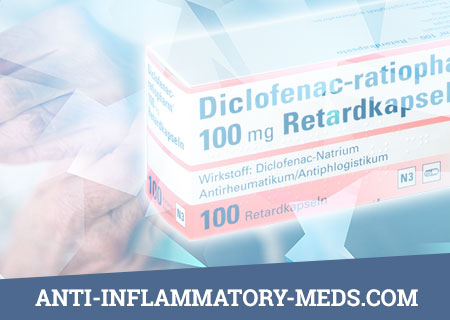Since ancient times, the connection between pain and inflammation. And today, the most common drugs for pain relief are drugs that have both anti-inflammatory and analgesic effects - non-steroidal anti-inflammatory drugs (NSAIDs).
The history of the creation of diclofenac
The prototype of modern NSAIDs was acetylsalicylic acid, which the young scientist Felix Hoffman was able to synthesize for the first time at the end of the 19th century. The chemical structure and properties of acetylsalicylic acid became the guidelines on which new members of this class of drugs were created (at first, they were usually referred to as “aspirin-like”). Not so much lack of effectiveness, as the toxicity of high doses of acetylsalicylic acid served as a powerful incentive for the development of new, "non-salicylate" NSAIDs. In 1966, during the implementation of a program to develop an anti-inflammatory drug with improved biological properties, more than 200 analogues of 0-aminoacetic acid were synthesized in the Geigy research laboratory to create a molecule with the required parameters, among which the most interesting results were shown by sodium diclofenac - sodium salt 0 - [(2,6 dichlorophenyl) -amino] -phenyl-acetic acid.

Initially, diclofenac was used mainly in the treatment of rheumatological diseases, where both components are important: a pronounced anti-inflammatory and powerful analgesic effect, but, subsequently, the scope of diclofenac significantly expanded. Currently, diclofenac is used in surgery, traumatology and sports medicine (with damage to the musculoskeletal system, soft tissue damage (bruises, sprains), for postoperative pain relief), in neurology (for the treatment of back pain, tunnel syndromes, migraines), gynecology for dysmenorrhea, adnexitis, in oncology as a means of the first step of anesthesia of the WHO staircase. Intramuscular administration of diclofenac sodium is an effective method of dealing with renal and hepatic colic. A special dosage form of diclofenac in the form of drops has found application in ophthalmology. General practitioners also prescribe diclofenac for various pain syndromes.
Mechanism of action of diclofenac
The analgesic effect of diclofenac is due to several mechanisms. The main mechanism of action of diclofenac is the suppression of cyclooxygenase (COX) - an enzyme that regulates the conversion of arachidonic acid to prostaglandins - mediators of inflammation, pain, fever.
Diclofenac and COX selectivity
In the early 90s of the twentieth century, two isoforms of the COX enzyme, COX-1 and COX-2, were found. Most of the positive effects of NSAIDs (suppression of inflammation, pain, fever) are associated with inhibition of COX-2, and the development of adverse reactions (mainly in the form of lesions of the gastrointestinal tract) - with suppression of the synthesis of COX-1.
However, there are some exceptions to this rule. It has been shown that COX-1 may also play a role in the development of the inflammatory process. COX-1 together with COX-2 is produced by the synovial membrane of patients with rheumatoid arthritis (RA). Probably, the lower effectiveness of selective COX-2 is associated with this in some pain syndromes. Recent studies have found an increased risk of developing cardiovascular complications with the use of highly selective COX-2 inhibitors.
Diclofenac inhibits both of the COX isoenzyme, to a greater degree COX-2. Inhibition of COX-1 in diclofenac is less compared to ibuprofen and naproxen, and therefore diclofenac less frequently causes damage to the gastrointestinal tract. At the same time, inhibition of COX-1 (although less pronounced than in non-selective NSAIDs) may explain the greater efficacy of diclofenac compared with selective COX-2 inhibitors (meloxicam, celecoxib) in a situation when COX-1 is involved in the pathogenesis of the disease ( for example, with RA). Inhibition of COX-2 in diclofenac is less than in etoricoxib and rofecoxib, which leads to a decrease in the risk of cardiovascular complications. This balanced effect of diclofenac provides a high therapeutic activity with good tolerability of treatment.
Other mechanisms of diclofenac analgesic action
In addition to inhibition of prostaglandins, other mechanisms of action of diclofenac have been identified. In an experimental study, it was shown that diclofenac sodium can significantly inhibit the migration of leukocytes to the focus of inflammation. To a certain extent, diclofenac sodium can also affect the cytokine balance, reducing the concentration of interleukin-6 and increasing the content of interleukin-10. This change in the ratio of these products is conducive to slowing the secretion of anti-inflammatory factors. The decrease in the production of free oxygen radicals, which occurs under the influence of diclofenac sodium, can also contribute to a decrease in the activity of the inflammatory process and limit its damaging effects on tissue.
In addition to the pronounced anti-inflammatory activity, diclofenac sodium also has a powerful analgesic potential unrelated to its effect on inflammation. It has a complex effect on various mechanisms of perception of pain, providing effective suppression of pain syndrome of various etiologies. The drug has both central and peripheral antinociceptive effects.
The central analgesic activity of diclofenac sodium is mediated by opioid receptors, as evidenced by the fact that this effect is blocked by naloxone. It seems to be associated with the effect of diclofenac sodium on tryptophan metabolism. After the introduction of the drug in the brain, the concentration of tryptophan metabolites, which can reduce the intensity of pain, significantly increases.
The local antinociceptive effect of diclofenac sodium seems to be associated not only with the suppression of prostaglandin synthesis, since in several experimental models of pain syndrome the local use of prostaglandin synthesis inhibitors such as indomethacin and celecoxib, unlike sodium diclofenac, did not allow for significant analgesic effect. The peripheral analgesic effect of diclofenac sodium is not associated with the opioid effect, since it is not eliminated by naloxone. At the same time, the use of compounds blocking the formation of NO and the activation of guanylate cyclase, suppressed the analgesic effects of diclofenac sodium. Inhibitors of various types of potassium channels also had a similar effect. In rat cerebellum cell culture, diclofenac sodium increased the activity of potassium channels, increasing potassium output from the cell. These results suggest that the peripheral antinociceptive effect of diclofenac sodium may be associated with the activation of several types of potassium channels that occur with the participation of NO and guanosine cyclomonophosphate (cyclo-GMP).
Thus, the analgesic effect of diclofenac may be due to its effect on various levels and links of the pathogenesis of the pain syndrome. In addition to the analgesic effect associated with the reduction of inflammation in the damage zone by inhibiting prostaglandins (COX-1 and COX-2), diclofenac can reduce pain, reducing inflammation and through other mechanisms (restraining the migration of leukocytes to the inflammatory focus, affecting the balance of cytokines) by acting potassium channels at the peripheral level, as well as reduce the perception of pain through central mechanisms (by increasing the synthesis of serotonin precursor (tryptophan) in brain tissue).
Indications for use diclofenac
Despite the wide range of existing NSAIDs and the creation in recent years of a new class of symptomatic anti-inflammatory drugs (selective COX-2 inhibitors), diclofenac sodium remains the most popular drug among NSAIDs.
The use of diclofenac in rheumatology
From the very beginning of its appearance, diclofenac has found wide application in rheumatology. An important feature that allowed diclofenac to oust other drugs from the NSAID group that were used before was its high analgesic and analgesic activity, along with good tolerability.
The effect of diclofenac is manifested by a decrease in the duration of morning stiffness, a decrease in pain (at rest and during movement), a decrease in swelling, swelling of the joints, as well as an improvement in the functional ability of the joints, which contributes to an increase in the range of motion. Diclofenac is the drug of choice for most rheumatological diseases and is used to treat inflammatory and degenerative rheumatic diseases (arthritis, arthrosis, etc.).
The use of diclofenac in general medical practice, orthopedics, traumatology, sports medicine
The most common in general medical practice are disorders of the musculoskeletal system. The pathology of the musculoskeletal system is diverse in etiology and pathogenesis. Pain in this group of lesions can be caused by trauma, degenerative processes, inflammation, dysplasia, trophic changes (osteoporosis). The mechanisms of disease development can be inflammatory, mechanical, neurogenic, etc. The pronounced analgesic effect of diclofenac with moderate and severe pain, inflammatory processes occurring after operations and injuries, rapid relief of spontaneous pain and pain during movement, reduction of inflammatory edema at the wound site made this drug one of the most necessary for the treatment of disorders of the musculoskeletal system, which are found in general practice, orthopedics, traumatology, sports medicine, neurologists and.

In the treatment of orthopedic and traumatic injuries, the form of release of the drug also matters. The possibility of combining local and common forms of diclofenac allows for maximum effectiveness while minimizing possible side effects. Local forms of diclofenac are most widely used for diseases of extra-articular tissues (tendovaginitis, bursitis, rheumatic affection of soft tissues), injuries to tendons, ligaments, muscles and joints. General forms, such as tablets, suppositories, solutions for injections,? - with massive injuries (combined and combined injuries, postoperative conditions, head injuries, fractures of large bones, etc.).
The use of diclofenac in neurology
Diclofenac is widely used for the relief of pain syndromes in neurological practice. Diclofenac is indicated for the treatment of acute back pain, with tunnel syndromes (carpal tunnel syndrome, cubital channel syndrome, etc.), with migraine.
The duration of use and the method of administration of the drug depend on the intensity of the pain syndrome. In moderate pain syndromes that do not limit the patient’s motor capabilities, it is possible to apply painful areas (spastic muscle) of gels and ointments containing diclofenac sodium for 7–10 days. With intense pain, which significantly limits the movement of the patient within the premises, injection routes of administration of diclofenac sodium are used for 3–7 days with a further transition to oral forms. There are reports of higher efficacy of phonophoresis with diclofenac compared with the use of ointment forms of the drug.
The use of diclofenac in gynecology
The ability to eliminate pain and reduce the severity of blood loss in primary dysmenorrhea allowed the use of diclofenac in gynecological practice. In primary dysmenorrhea, the daily dose is selected individually; it is usually 50–150 mg. The initial dose should be 50-100 mg; if necessary, for several menstrual cycles, it can be increased to 150 mg/day. Reception of diclofenac should be started when the first symptoms appear. Depending on the dynamics of the clinical symptoms, treatment can be continued for several days. Diclofenac can also be used in inflammatory diseases of the small pelvis, including adnexitis.
 US
US AU
AU UK
UK DE
DE FR
FR IT
IT ES
ES



